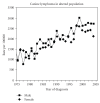Hormonal and sex impact on the epidemiology of canine lymphoma
- PMID: 20445802
- PMCID: PMC2859020
- DOI: 10.1155/2009/591753
Hormonal and sex impact on the epidemiology of canine lymphoma
Abstract
The Surveillance Epidemiology and End Results data demonstrate that the risk of non-Hodgkin lymphoma is lower for women, but that the incidence increases after fifty years of age, at which menopause is regularly reached, suggesting that female hormones may be protective for NHL. This study examines the influence of sex on lymphoma risk in a relevant large animal model. Records for dogs in the Veterinary Medical Database were analyzed from 1964 to 2002. Risk ratios were calculated to evaluate associations between sex, neutering status, and lymphoma occurrence. A total of 14,573 cases and 1,157,342 controls were identified. Intact females had a significantly lower risk of developing lymphoma, Odds Ratio 0.69 (0.63-0.74) with a P < .001. We conclude that there is a sex effect on NHL risk in dogs similar to humans. We hypothesize that the hormone levels of intact females lower the risk of NHL. The possibility of a protective role of endogenous estrogens in the etiology of NHL should be investigated.
Figures




References
-
- Alexander DD, Mink PJ, Adami HO, et al. The non-Hodgkin lymphomas: a review of the epidemiologic literature. International Journal of Cancer. 2007;120:1–39. - PubMed
-
- Fournel-Fleury C, Magnol JP, Bricaire P, et al. Cytohistological and immunological classification of canine malignant lymphomas: comparison with human non-hodgkin’s lymphomas. Journal of Comparative Pathology. 1997;117(1):35–59. - PubMed
-
- Vail DM, MacEwen EG. Spontaneously occurring tumors of companion animals as models for human cancer. Cancer Investigation. 2000;18(8):781–792. - PubMed
-
- Khanna C, Lindblad-Toh K, Vail D, et al. The dog as a cancer model. Nature Biotechnology. 2006;24(9):1065–1066. - PubMed
Grants and funding
LinkOut - more resources
Full Text Sources

